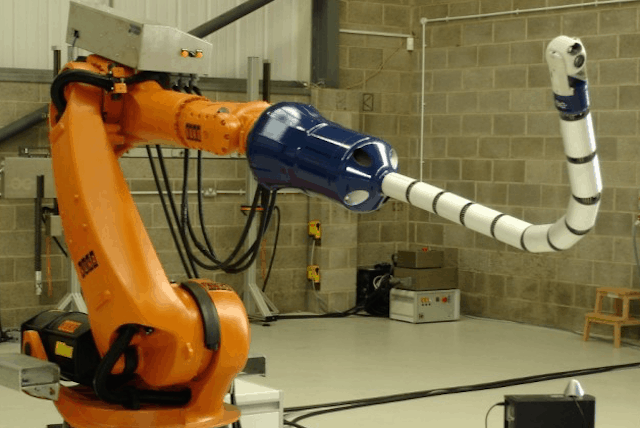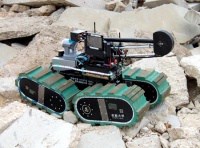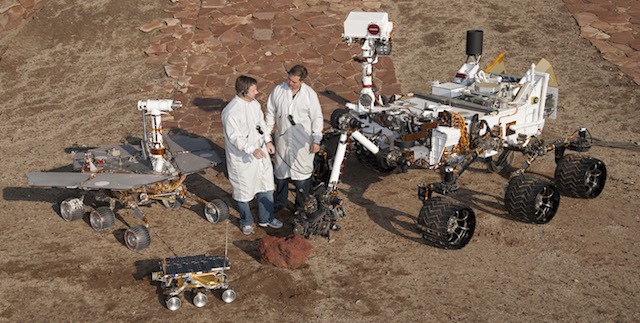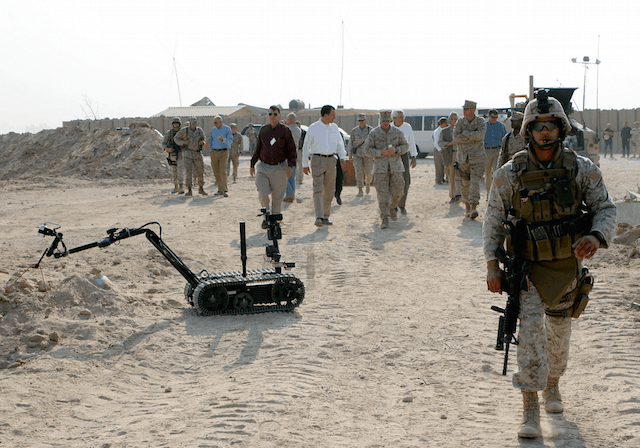In the last few decades, robots have advanced from the realm of science fiction to become an essential technology for a host of applications. In particular, robots are often designed for tasks that would be too tedious, too precise, or too dangerous for humans to be expected to do for long periods. In the last of these categories are the hazardous areas robots, which work under conditions that humans can either not handle at all, would require too much protective equipment for the task to be worthwhile, or simply cannot reach: in the heart of nuclear reactors, in space, under the sea, or in environments where the atmosphere is too dangerous for people to stay.
We put your questions on hazardous area robots to experts in the field, including:
Prof Robin Murphy (RM) of the department of Computer Science and engineering at Texas A&M University. One of the leading experts in the field, Prof Murphy is the director of the Centre for Robot-Assisted Search and Rescue, and specialises in artificial intelligence for mobile robotics.
Shaun Whitehead (SW), founder and director of Scoutek, who develops terrestrial and space exploration robots. Previously, a systems engineer at space technology specialist Magna Parva, Whitehead has worked on projects including the ExoMArs European robotic rover mission to Mars; snake robots for archaeology in the Great Pyramid at Giza; tunnelling machines; and the Indian robotic lunar rover Chandrayaan 2.

Realistically, when would these types of devices be cleared for use in Britain’s nuclear industry? What standards are being defined for operators and site licence holders?
RM: Unmanned systems are essentially ‘good enough’ for use now. They are not perfect but they won’t improve until there is significant use, leading to meaningful feedback to the manufacturers, who will be incentivised by the market.
What markets are we looking at here for the use of these machines in nuclear reactors? Does the panel think that they will play a part in the decommissioning of the UK fleet, or are they looking more toward similar work with foreign fleets? Also, where does the UK stand – if we were to rank these things – in developing these machines, compared to the rest of the world?
RM: I can’t imagine how decommissioning can be done cost-effectively without robots. I do not know where the UK stands in development.

To what degree do developments made in the defence sector filter through to robots that are designed for use in other extreme environments?
RM: The defence sector has been critical in developing unmanned ground and aerial systems. For example, the QinetiQTalon and iRobot Packbot, which were used in the immediate response and mitigation phase of the Fukushima nuclear accident and are heavily used in the decommissioning, were developed as part of the US Defense Advanced Research Projects Agency’s Tactical Mobile Robots programme. The Honeywell T-Hawk used at Fukushima was also developed by DARPA. The military is a medium-volume, high-profit technology market. The nuclear industry is a very low-volume, medium-profit technology market – there is no market incentive for companies to invest in R&D, only to adapt what they have built for the military.
SW: There are some examples of complete robots from the defence sector that can be used for other extreme environments, but probably the biggest transfer is not of complete robots but rather individual components – i.e. the parts, or enabling technology, such as radiation hard electronics.
Most ‘extreme environment’ robots tend to be remotely operated. Do autonomous robots (for example, with no outside control and onboard decision making) have any potential in this area? And can the panel identify any specific examples?
RM: The role of autonomous capabilities depends on the mission, the environment and robot. Manufacturers have tended to be either-or in terms of terms of teleoperation/navigational autonomy, in part because the US military has not been able to create test and evaluation methods for complex human-machine interaction and thus hasn’t pushed for it. If the robot is being used for exploration, then having an operator drive and look opportunistically as interesting features come up, but have the robot autonomously avoid obstacles and build a map, is useful. If you want the robot to come back home at the end of the day, that is another set of capabilities. If the robot is performing dexterous manipulation, a human is generally involved in the fine motion because the computer vision systems aren’t good enough.
SW: Autonomous or semi-autonomous robots not only have potential, but are already absolutely necessary in some cases. For space robots, the communication delay caused by huge distances between operator and robot mean that it is not practical to directly remote control the spacecraft. Practically every planetary spacecraft and lander is a great example of this autonomy. As we push the boundaries in other extreme environments on Earth, we will reach the limit of communication or tether distances, and so autonomy is going to be essential.

Hazardous areas describes a wide variety of conditions, but are there any common features or systems that might be used for all ‘danger zone’ robots, or in robots for particular areas? For example, what might an undersea robot have in common with a space robot?
RM: Robots of all types can be thought of as consisting of the following subsystems: control system, effectors (skids, wheels, arm), sensors, power, and communications.
SW: There aren’t necessarily features that are common to all ‘danger zone’ robots, but there are certainly common challenges between different fields. Ionising radiation is a challenge for space and nuclear (civil and military) robotics. Nuclear decommissioning robots often have to survive in a much more harsh radiation environment than space robots. The development of radiation-hard electronics has been accelerated by space missions, and so designs and processes for rad-hard space hardware are transferable to nuclear. Increasingly, autonomy of robots for hazardous areas is going to become important, and that is what several have in common.
Obviously, there are many different types of extreme environment, each with its own set of challenges. Could the panel identify the particular challenges that relate to their main applications areas?
RM: The major challenge I’ve seen in our analyses is human factors. Over 50 per cent of the terminal failures of robots in 29 disasters were attributed to human error. But the true human at fault was the designer. Often the operator did not have the right display or sensor that could have let him detect and prevent the failure; or the designer expected the operator to react faster than the human nervous system can process input.
SW: The main application area of Scoutek is space exploration, and space is an awfully big place with every extreme. We’ve worked on missions to Mercury, where the surface temperature is 174°C, and missions to Mars, where the surface temperature can easily reach -120°C. Ultraviolet radiation and ionising radiation from the sun, the cosmos and trapped within the Van Allen radiation belts cause components to weaken and fail. Operation in vacuum and partial vacuum bring their own sets of challenges, especially for tribology and material degradation and contamination by outgassing. Dust is a huge issue; lunar dust is a great abrasive. As if all of that is not enough, we add our own extreme environment by placing sensitive instruments into huge rockets that vibrate all the way up to orbit. And when we visit another planet to look for signs of life, we don’t want to take our own microbial hitch-hikers, and the process to sterilise the spacecraft can be just as tough as any environment that space can throw at us.

We’ve seen iRobot’s Packbot used for bomb disposal in the Middle East and even in the hunt for the Boston bombers. What role does the panel think robots might play in future anti-terror operations?
RM: Unmanned systems are generally thought of as responding to an event, but these same technologies can be used to prevent events. For example, unmanned marine vehicles can routinely patrol ports and inspect the hulls of ships for contraband or detect radiation that would be otherwise shielded. Aerial and marine vehicles can monitor and survey bridges and critical infrastructure. Ground vehicles can autonomously build up-to-date maps of key buildings at night.
SW: For anti-terrorism, I think that data-based security will have more of an impact, but there is always a need for smaller and less easily observed ‘spy’ robotics.
Does the potential market for hazardous robots not pale in comparison to that of more everyday types of automation? Will that restrict innovation in either sector as a result?
RM: The market for hazardous robots pales in comparison to industrial, agricultural, and consumer-based applications. Robots working in hazardous environments have constraints on platforms, for example, radiation hardening, intrinsically safe, etc., that drive the cost upwards. Also they have
to be more reliable because they cannot make the situation worse.
SW: The value of the market or robots for hazardous environments is potentially huge, even if not as widespread as ‘everyday’ automation. A couple of examples: eventually mankind is going to want to mine the moon and asteroids, and you can’t get a more hazardous environment than those places. Nuclear decommissioning is always going to be needed, even if facilities have decommissioning designed into them from the beginning. Even though it’s not really related to this whole topic, I believe that we are almost at the tipping point of robotics for everyday use, and there will be plenty of innovation there. Right now, the mentality is that we will build a few expensive machines for specialist tasks, but soon the market will wake up to successes that would normally have remained in the lab or just for specialist use. The development cost has already sunk, and some companies have realised that their technology can be mass produced, creating a need that some may not have realised was there.





Swiss geoengineering start-up targets methane removal
Several rather dubious statistics in this report. IF methane had 120× the thermal effect of CO2 that would be TWO orders of magnitude. Two is not...